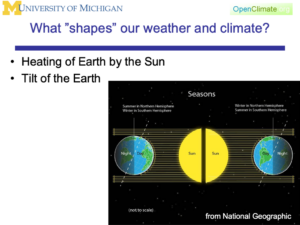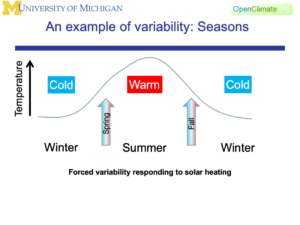Let’s demystify
In a 2021 column titled “The hot topic of temperature analysis,” I wrote that one of the most common subjects people challenge me with is ice-age cycles. They know the Earth has experienced several ice ages at more-or-less regular intervals, and between ice ages there were more temperate periods.
They tell me that what is happening today is just another cycle.
In the past month, I have had several people tell me more generally that climate is cyclic or periodic. Therefore, they say, when climate scientists talk about trends in sea level rise, for example, they are exaggerating and nonsensical. These folks suggest climate scientists choose to ignore the cycles.
We do not. Cycles exist all around us. In our day-to-day experiences, one of the most prominent cycles we experience is the march of the seasons.
It is warmer in summer and cooler in winter. Fall and spring are transitions between summer and winter. We play and watch different sports in different seasons. We have engrained the seasonal cycle deeply into our behavior.
The seasonal cycle is well understood by the configuration of Earth relative to the Sun. Because of the tilt of the Earth on its rotational axis, it is summer when the northern hemisphere is pointed toward the Sun. It is winter when the northern hemisphere is pointed away from the Sun. When the northern hemisphere has summer, the southern hemisphere has winter, and vice versa.
Many other examples of cyclic behavior can be explored by looking at Earth’s seasonal cycle. As we move from winter to spring to summer, plant growth increases. After summer, plant growth declines, and leaves that grow in the spring months fall to the ground. We also see seasonal cycles in the migration of birds following heat and food.
A curious aspect of the transition from winter to summer is that as it gets warmer, carbon dioxide decreases. This occurs because plants not only require heat and water, but carbon dioxide. They consume carbon dioxide so fast that it reduces the amount in the atmosphere, despite the upward trend caused by burning fossil fuels.
 Some of that carbon dioxide is released in the fall; carbon dioxide increases as Earth cools for winter. We observe a seasonal cycle due to the biological take up and release of carbon dioxide. Seasonal heating and cooling are dominated by solar energy.
Some of that carbon dioxide is released in the fall; carbon dioxide increases as Earth cools for winter. We observe a seasonal cycle due to the biological take up and release of carbon dioxide. Seasonal heating and cooling are dominated by solar energy.
Another cause of periodic behavior comes from waves. The common types of waves we see on the surface of lakes and oceans arise from the wind pushing on the water and piling it up until the force of gravity pulls the water back down.
Water and air are fluids, and fluids are full of waves. Therefore, we should expect weather and climate to be full of cyclic or periodic behavior. When all these waves appear together, we are presented with vast complexity.
We are always looking for cycles
These examples are a reminder that we are used to cyclic behavior, and the causes of cyclic behavior need not be mysterious.
 When faced with an observation of a cycle, a science-based approach to understanding the observation is to ask: What are the competing forces? For example, the periodic behavior of waves described above can be described as the balance of two competing forces: wind stress and gravity.
When faced with an observation of a cycle, a science-based approach to understanding the observation is to ask: What are the competing forces? For example, the periodic behavior of waves described above can be described as the balance of two competing forces: wind stress and gravity.
Similarly, when faced with a set of observations full of variability, we use techniques to explore, identify, and extract waves and periodicities. As we examine a set of observations for evidence of a trend, we first have to account for all the other causes of variability.
These practices are fundamental to climate science and many other types of science and engineering.
There is, in fact, a very common and obvious example of an observational record of a cycle and a trend together. (See the carbon dioxide record shown in the figure above.) These observations from Mauna Loa, Hawaii, show the seasonal cycle described above, which is modulating the upward trend of carbon dioxide concentrations in the atmosphere.
What about the cycles
I’ve been asked how we can be sure we are observing trends in the climate rather than a natural cycle. Beyond curiosity, there is usually a challenge in the question. That challenge often arises because a large volume of available media is devoted to maintaining “natural cycles” as an alternative explanation to the trends we observe on Earth. Indeed, some of the advocates of natural cycles are scientists.
In some instances, those who advance these arguments claim that mainstream climate scientists have ignored these causes of variability. I have never found a case when this is true. In other instances, they turn to attack climate scientists as having some conspiratorial need to unite and deceive the world about global warming. This makes no sense to me, but it is hard to provide proof to those committed to conspiratorial thinking.
In all instances, those who maintain that cycles are an alternative to trends caused by increasing carbon dioxide and methane choose to take a narrow view of both the observations and the ability to characterize cyclic behavior and its causes. They hide information. Sometimes, they invoke “nature” as a mysterious force we’ll never understand.
In the past months, people have told me they obtained “the data” and personally analyzed it. They find variability, perhaps a cycle, for example, of a time when sea level rose over a couple of decades – then declined. They conclude, therefore, that sea level is cyclic and there is not a trend.
That conclusion is a logical flaw, a hasty generalization. What they can conclude is that there are cycles in sea level observations, and that cyclic behavior must be accounted for in order to draw conclusions about a trend. There are legitimate arguments about the methods used to account for cyclic behavior, but I know of no credible scientific papers where such an accounting is not made.
(Lead image: from iStock shows a roaded collapsing into the sea due to sea level rise on the Holderness coast in England.)





Tom Wagner - 69 &71, SNR&E
We cannot deny climate change — history documents cold/stormy periods (the Dark Ages, “the little ice age”) to warm/wet periods (“Middle Age Warming”) lasting decades to centuries. These climatic fluctuations are not well understood or uniformly distributed — some areas having droughts while simultaneously others having floods today. But all change involves costs as economies readjust to a changing “new normal”. While many people around the world are adversely affected by industrial-led warming, causing tragic losses, some areas actually have net benefits. Without ignoring environmental damages to lives and property, I’d suggest that Michigan has actually been benefiting from climate change — shorter winters and warmer, milder, longer growing/recreation seasons. We save hundreds of millions of dollars in lower heating costs and cold-weather disasters (flues, falls, and frozen pipes). We have longer crop growing and Great Lakes shipping seasons. In contrast, summers have not been notably warmer. Michigan might transition from its national reputation as a winter “ice box” to a great place to live, recreate, and retire!
Reply
Norb Roobaert - 1963
Very interesting subject. A cycle can be defined as recurring events over a specific period of time. A trend can be defined as a prevailing tendency or course of events. It seems that weather events are neither a cycle or a trend. We are trying to define the cause of weather events. It seems to me that we can make some general conclusions but very difficult to pin down. We can define what causes a hurricane but not when the conditions to form a hurricane will occur in the future.
Reply